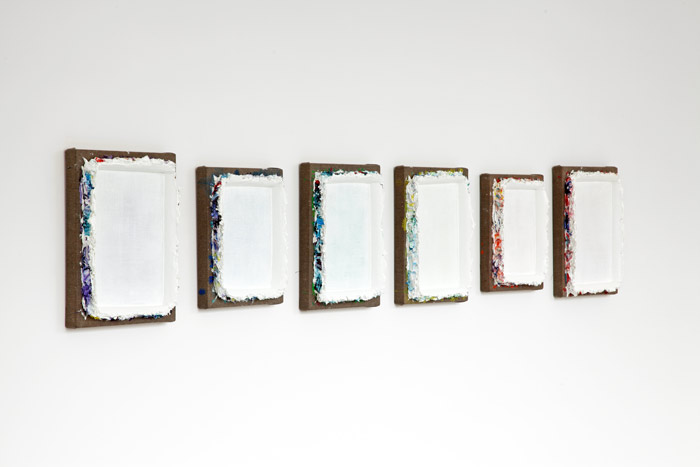A series of black and white surfaces, halfway between paintings and sculptures, articulate the walls in the new spaces of Galleria Franco Noero. Suburban Suprematism is the title of the third exhibition that Andrew Dadson presents in the gallery in Turin. The title itself reveals two of the main sources of Dadson’s artistic research: the empty, liminal spaces of suburban Vancouver, where he lives and works, and the theory of Suprematism, conceived by Kasimir Malevich in the first decades of the Twentieth century. Evoked by these square monochromatic paintings that deny any kind of representation. Dadson’s work draws from but is far from the Suprematist imperative of flat uniformly painted surfaces, geometric rigor, and detachment from the bonds of reality.
In order to achieve an expression of pure sensibility, Dadson’s work creates a dialogue with the objective and natural world. The three large photographs Black Dune, Black Barbed Wire and Black Garbage depict a certain suburban landscape in Vancouver, where the artist has previously intervened, covering select parts with a biodegradable black paint. Like a large sinister shadow, the dark color covers the sand, the grass, the plants, and the discarded objects lying on the ground. The black veil seems to cancel the space and, by absorbing the light and the sounds, it becomes an image in which the sense of desolation of this unbuilt, almost desert area is increased.
It reminds one of a shore, covered with tar and oil, or a natural landscape, cruelly transfigured by a fire. The black section is a sort of temporary square cut out into the landscape, which can still admire through the original colors remaining at the edges of the photographs. We recognize the ochre sand, the green plants and the blue sky. This action of negation is not addressed against the nature, whose regeneration slowly removes all of its traces, but is a way to investigate the concept of natural limits in relation to time, and also to space.
These works are the result of an exploration of the city and show how painting can be a physical presence, able to give new meaning to its anonymous boundaries as well as redefine the architectural setting of the open exhibition space.
The large-format abstract works on canvas are hung on the walls (Make Up) or leant on the floor of the gallery (Rundown), in a manner that expresses an attention to their sculptural quality. They are composed of many layers of different colors lying beneath the white or black tint, which represents only the last coat of this multi-layered surface. The other colors appear in transparency on the scraped monochromatic surface and at its edges, where we can see both the rough canvas and the complicatedly rich texture formed by the colors, sometimes applied directly from the tube.
The paintings can be admired from a frontal perspective, but also from a three-quarter view, where we become aware of the complex process that led to their material thickness. This is especially true of the Re-stretch series, a small series of paintings which can be seen to consist of all the range of colors of the rainbow. Frontally, we perceive only a white square that references a frame, smaller than the canvas, delimited by an accumulation of color noticeably thicker at the edges. All of this is then surrounded by the rough linen canvas. In the large-format paintings, the same tension between inside and outside is created by the color spreading out towards the edges, exceeding the limits of the painting space. In both cases, we see a blurring of the boundary between the fictional space of representation and reality.
A performative behavior, mindful of the gesture exposed by the American Abstract Expressionism, is at the core of Dadson’s creation. The rhythm of the paintings reflects the temporality of the action that has produced them; in the process of layering the memories of his visual experiences, they become absorbed and preserved. The work includes the vibrations of the action painting of Jackson Pollock, but also the physicality of the object ‘s presence in Robert Rauschenberg’s combine paintings. In Dadson’s work the accumulated matter transforms the canvas itself in an object which inhabits the real space, with the brightness of Mark Tobey’s white writing paintings. The colorful marks that appear, especially on the corners on the top and at the bottom of the canvases, reveal traces of the urban landscape, with its illegible graffitied walls, while the shape of the works reminds one of overlapping advertising posters.
Not Titled Yet, displayed in a separate room, consists of four sheets of paper representing four different stages of the same process, dealing again with the concept of time. The black color on the white paper, the almost square shape, the diagonal folds, the black cross that appears as the result of the whole composition, all point to the indivisible unity and coexistence of subject, matter, technique, support and process; leading once again back to Suprematism. The sequence of drawings, in its simplicity, is an essential gesture which contains all the seeds of possible developments in Dadson’s work. It is the starting point of a system which generates a repertoire of shapes, distortions, displacements, cancellations, accumulations, and superimpositions.
By Sara De Chiara
























